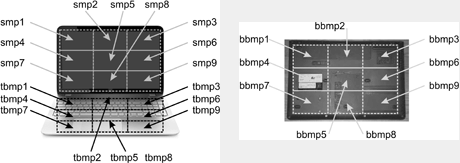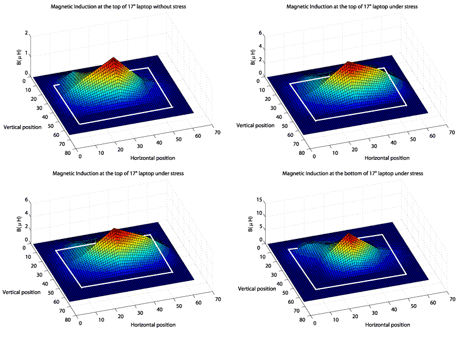by Darko Brodić and Alessia Amelio
We present an analysis of the extremely low frequency magnetic field radiation produced by laptop computers in normal conditions and under stress.
A laptop is a portable all-in-one computer powered by AC or battery. Owing to its portability, it is quite commonly used in close contact with the body, i.e. touching areas of skin, blood, lymph, bones, etc. It has been suggested that this might have negative effects on the user’s health, due to the effect of the non-ionized electromagnetic radiation (EMR) characterized by extremely low frequency up to 300 Hz.
The risk of extremely low frequency magnetic exposure for laptop users has been partly analyzed [1], [2]. The World Health Organization has recognized the occurrence of hypersensitivity to electromagnetic radiation, including dermatological symptoms as well as neurasthenic and vegetative symptoms. The referent limit level is defined as the critical level of EMF radiation (extremely low frequencies), above which the environmental conditions can be unsafe for humans. This has been set as up to 0.3 μT [1], [2].
We address the problem of the magnetic field radiation to which users are exposed by their laptops. We have developed a new approach to measure and classify uniform extremely low frequency magnetic fields, produced in the laptop neighbourhood [3]. The intensity of the magnetic induction B in the direction of the Cartesian axes x, y and z is measured by Lutron EMF 828 devices. We propose 27 measurement points in the laptop neighbourhood, divided into three groups: screen measurement points, top body measurement points and bottom body measurement points.
The value of the magnetic field B around the laptop is measured under ‘normal conditions’ and under stress. The normal operating condition means that the laptop runs typical programs such as Word, Excel, Internet browsing, etc. The under stress laptop operations are introduced as a new approach to measurement. We consider extreme computer operations, when all parts of the laptop are under heavy load. This is achieved by running the 3DMark Vantage program, which represents the well-known computer benchmarking tool created to determine the performance of a computer 3D graphic rendering and CPU workload processing capabilities.

Figure 1. Measurement points in the laptop neighborhood: at the top part of a portable computer (left), at the bottom part of a portable computer (right).

Figure 2. EMF measured values (white line represents the border of the laptop): (a) at the top part of a laptop (without stress), (b) at the top part of a laptop under stress, (c) at the bottom part of a laptop (without stress), (d) at the bottom part of a laptop under stress.
The results of the experiment are given for 10 laptops. They show that the level of EMF radiation in the laptop screen area is negligible or in the order up to 0.02 μT. Accordingly, only the results of EMF obtained at the top and bottom body part of laptops are considered. Six out of ten laptops are tested in normal conditions and under stress, while the other four laptops are only tested under normal conditions. The experiment shows that the EMF values measured under stress are two to three times higher than those obtained in the normal operating condition. Furthermore, the level of EMF at the bottom part of the laptop is higher than at the top part.
In conclusion, extreme caution is needed when using a laptop. We advise: (i) connecting an external keyboard, (ii) connecting the mouse, and (iii) keeping the laptop out of the lap by putting it on a desk or table.
Finally, we measured the EMR for 10 different laptops under normal conditions. The EMF measurements are partitioned into classes leading to the establishment of different levels of dangerous and non-dangerous zones in the laptop neighbourhood. Furthermore, the areas of the laptop which are more or less dangerous when in direct contact with the user are defined. This information will provide valuable input for the design of computer inner components.
Future research will classify laptop EMF radiation under both normal and stress conditions.
The approach described is part of a project proposal which will consider the impact of the EMF radiation in the office. The bilateral research project, in collaboration with the National Research Council of Italy, will be carried out by the Technical Faculty in Bor at the University of Belgrade (Serbia). This work was partially supported by the Ministry of Education, Science and Technological Development of the Republic of Serbia TR33037.
References:
[1] S. A. Hanna, et al.: “Measurement Evaluations of Static and Low Frequency Magnetic Fields in the Near Field Region”, Measurement, 44(8):1412-1421, 2011.
[2] C. V. Bellieni, et al.: “Exposure to Electromagnetic Fields From Laptop Use of ‘Laptop’ Computers”, Archives of Environmental & Occupational Health, 67(1):31-36, 2012.
[3] D. Brodić: “The Impact of the Extremely Low Electromagnetic Field Radiations from the Portable Computers to the Users”, Revista Facultad de Ingenieria-Universidad de Antioquia, in press.
Please contact:
Alessia Amelio, ICAR-CNR, Italy
E-mail:











